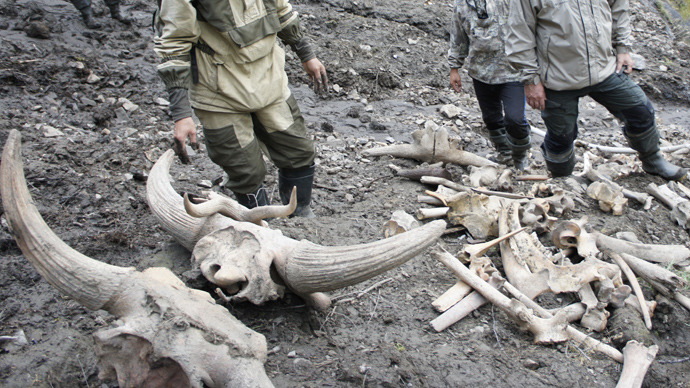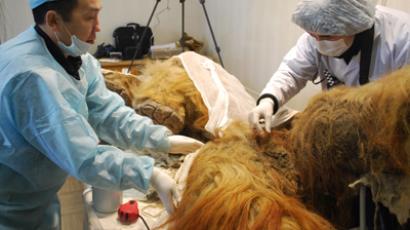Mammoth find: Preserved Ice Age giant found with flowing blood in Siberia

Russian scientists discovered a fully-grown female mammoth with blood and well-preserved muscle tissue trapped in ice in Siberia. The findings come amid debates on whether the extinct species should be resurrected using DNA.
Scientists say they have managed to find mammoth blood during the
excavation of a grown female animal on the Lyakhovsky Islands,
the southernmost group of the New Siberian Islands in the Arctic
seas of northeastern Russia.
The dark blood was found in ice cavities below the belly of the
animal. When researchers broke the cavities with a poll pick, the
blood came flowing out. The fact surprised them because the
temperature was 10C below zero.
"It can be assumed that the blood of mammoths had some cryo-protective properties,” said Semyon Grigoriev, head of the Museum of Mammoths of the Institute of Applied Ecology of the North at the North Eastern Federal University as cited by Interfax news agency.
The blood was placed in a test tube and a bacteriological
analysis of the sample is expected soon.
The muscle tissue of the animal was also well-preserved and had a
natural red color of fresh meat, added the scientist. Such
preservation can be explained by the fact that the lower part of
the mammoth’s body was trapped in pure ice, while the upper part
was discovered in the middle of the tundra. The trunk was found
separately from the carcass.
The researchers established that the female mammoth was between 50 and 60 years old when it died. Grigoriev noted that this was a unique find likely to prompt international intrigue.

"We are the first in the world to find the carcass of an adult
female mammoth. Now she, along with the bones and some ice,
weighs about one ton. We assume that during life she weighed
about three tons," he acknowledged.
The head of the museum also suggested that the mammoth lived from
10,000 to 15,000 years ago.
Scientists have suggested that perhaps the animal fell through
the ice, escaping from predators. However, its thought the
predators still feasted on part of trapped mammoth.
Foreign experts are expected to see the unique mammoth material in July, according to reports.
Three adult mammoth carcasses, including the latest discovery of
the Yakut scientists, have been found in the history of
paleontology. However, despite such a good state of preservation,
the scientists have not yet found enough living cells for cloning
the species. Grigoriev noted that the repair of DNA is a very
complex process that can take years.
The latest discovery and its research heralds the possibility of
bringing the animal back to life in the future, though there is a
lot of controversy around the issue of cloning.
A team of researchers from Russia and South Korea in September 2012 said they had discovered mammoth tissue fragments buried under meters of permafrost in eastern Siberia that could contain living cells. However the number of cells was too few to achieve successful cloning and the issue was treated with skepticism by many stem cell scientists.
Mammoths are believed to have died off around 4,000 years ago. There is dispute among scientists about the exact cause of the extinction - climate change and hunting by man are frequently cited as causes.














